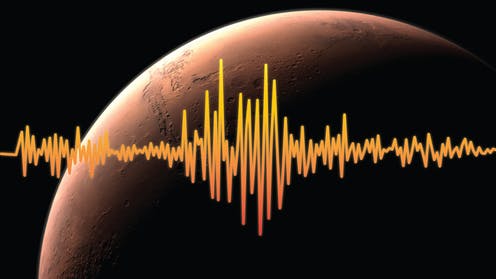This video and audio illustrates a seismic event detected by NASA’s InSight on April 6, 2019, the 128th Martian day, or sol, of the mission. Three distinct kinds of sounds can be heard, all of them detected as ground vibrations by the spacecraft’s seismometer, called the Seismic Experiment for Interior Structure (SEIS): There’s noise from Martian wind; the seismic event itself; and the spacecraft’s robotic arm as it moves to take pictures.
This event is the first likely marsquake recorded by the InSight team.
Several other seismic events have been recorded but are much more ambiguous than this signal.
The audio underscores just how seismically noisy the Martian surface can be and was produced from two sets of sensors included with SEIS. Audio from both sets of sensors have been sped up by a factor of 60; the actual vibrations on Mars would not have been audible to the human ear.

Marsquake
While quakes have been observed and well-documented on the Moon, as well as compelling evidence of quakes on Venus, very little is known about the current seismic activity of Mars, with some estimations suggesting that marsquakes occur as rarely as once every million years or more. Nevertheless, compelling evidence has been found that Mars has in the past been seismically active, with clear magnetic striping over a large region of southern Mars. Magnetic striping on Earth is often a sign of a region of particularly thin crust splitting and spreading, forming new land in the slowly separating rifts; a prime example of this being the Mid-Atlantic Ridge. However, no clear spreading ridge has been found in this region, suggesting that another, possibly non-seismic explanation may be needed.
The 4,000 kilometres (2,500 miles) long canyon system, Valles Marineris, has been suggested to be the remnant of an ancient Martian strike-slip fault. However, even if it was at some point an active fault, it is unknown whether the fault is still active, or if it has “frozen” into place.
Well it seems something is rumbling… We now need to find the source!











